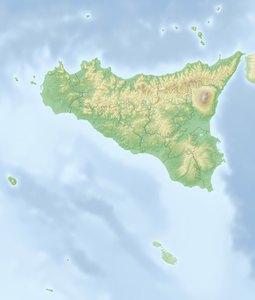Salina (island)
| Salina | ||
|---|---|---|
| Port in Santa Marina Salina | ||
| Waters | Tyrrhenian Sea | |
| Archipelago | Aeolian Islands | |
| Geographical location | 38 ° 33 '53 " N , 14 ° 50' 19" E | |
|
|
||
| length | 7.5 km | |
| width | 5.5 km | |
| surface | 26.8 km² | |
| Highest elevation | Monte Fossa delle Felci 962 m slm |
|
| Residents | 2500 (2009) 93 inhabitants / km² |
|
| main place | Malfa | |
| The Aeolian Islands | ||
The island of Salina and its neighboring islands of Lipari , Vulcano , Filicudi , Alicudi , Panarea and Stromboli belong to the archipelago of the Aeolian Islands , which are located in the Tyrrhenian Sea off the northern coast of Sicily .
The three municipalities of Santa Marina Salina , Malfa and Leni , which belong to the metropolitan city of Messina in the Italian region of Sicily , are located on Salina .
geography
Salina is located northwest of the main island of Lipari . With 26.8 km² it is the second largest of the Aeolian Islands and is also of volcanic origin. The appearance of the island is shaped by the twin volcanoes Monte Fossa delle Felci (962 m) and Monte dei Porri (860 m).
In contrast to the other islands of the archipelago, Salina has a fresh water source and is therefore rich in vegetation. Since 1983 the whole island has been under nature protection except for the immediate vicinity of the places and a narrow coastal strip in the northeast.
On the north coast is the municipality of Malfa (937 inhabitants; as of December 31, 2009) with the towns of Malfa and Pollara. On the east coast is the municipality of Santa Marina Salina (885 inhabitants) with the towns of Santa Marina Salina and Lingua, on the south coast the municipality of Leni (678 inhabitants) with the towns of Leni and Rinella.
The island's ferry port is in Santa Marina Salina, and there is another landing stage in Rinella.
history
Salina was already inhabited in the Middle Bronze Age. This is proven by the findings of a small Milazzese settlement near Portella, in the northeast of the island. The village, which consisted of round or oval huts, 17 of which have been excavated so far, was built around the middle of the 15th century BC. In the settlement were u. a. Large storage vessels ( pithoi ) discovered that could hold up to 500 liters of water. While Bernabò Brea , who started archaeological research on the settlement in the 1940s, saw the end of Portella through a catastrophic fire in the first half of the 13th century BC. After recent excavations in 2006 and 2008, radiocarbon dates showed that the settlement apparently only existed for a relatively short time and was already destroyed and abandoned towards the end of the 15th century.
The Greek name of the island Didyme (Δίδυμη = twin) was derived from the two volcanoes that characterize the landscape. The Latin name Salina (salty) comes from the time of Roman rule, when there were large salt lakes in the southeast of the island.
Salina has been independent from the municipality of Lipari since 1867 .
economy
The main occupations of agriculture are the cultivation of the Malvasia di Lipari grape variety , from which the Malvasia delle Lipari typical of the region is produced, and the caper harvest . Together with the Sicilian island of Pantelleria , Salina supplies 95% of the Italian caper harvest. In summer tourism is another important source of income for the residents.
Culture
The pilgrimage church of Madonna del Terzito is the oldest Marian shrine in the archipelago. It stands on the foundations of an ancient Roman temple, was built from 1622 and thoroughly renovated from 1901. Solemn processions take place on the feast days of the Madonna.
Since 1991, the municipality of Malfa has organized the Sagra del cappero , the caper festival, on the first weekend in June , in which original costumes are worn and traditional music is celebrated.
In 1984 the Taviani brothers shot the film Kaos on Salina . In 1994 Michael Radford shot the film The Postman in Pollara , which was a great success worldwide and received 18 film awards.
Stratovolcano Monte dei Porri
literature
- Peter Amann: Aeolian Islands. With practical travel tips for Naples and Milazzo. 5th updated edition. Iwanowski's Reisebuchverlag, Dormagen 2010, ISBN 978-3-933041-91-3 .
- Eva Gründel, Heinz Tomek: Lipari Islands. DuMont Reiseverlag, Cologne 2003, ISBN 3-7701-6028-2 .
Web links
- Georg Weindl: How the film "Il Postino" brought fame to the Italian island of Salina and yet did not change the locations. The postman's island. In: The time. September 19, 1997. Retrieved April 22, 2018 .
- Salina on SkipperGuide Nautical information about Salina
- Information on the Bronze Age settlement of Portella
Individual evidence
- ↑ Gianmarco Alberti: Radiacarbon evidence from the Middle Bronze Age settlement of Portella (Aeolian Islands, Italy). Chronological and archaeological implications. Radiocarbon 53-1, 2011, pp. 1-12. on-line







